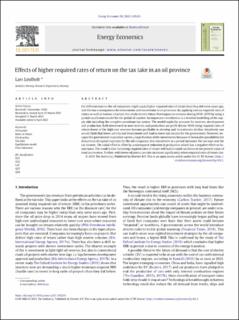| dc.contributor.author | Lindholt, Lars | |
| dc.date.accessioned | 2022-03-21T16:07:50Z | |
| dc.date.available | 2022-03-21T16:07:50Z | |
| dc.date.created | 2021-04-19T15:07:06Z | |
| dc.date.issued | 2021-06 | |
| dc.identifier.citation | Energy Economics, 2021, 98 (June), 105265. | en_US |
| dc.identifier.issn | 0140-9883 | |
| dc.identifier.uri | https://hdl.handle.net/11250/2986627 | |
| dc.description.abstract | For different reasons the oil companies might apply higher required rates of return than they did some years ago, and this has consequences for investments and tax revenue in oil provinces. By applying various required rates of return as well as various oil prices, this study derives future Norwegian tax revenue during 2018–2050 by using a partial equilibrium model for the global oil market. An important contribution is a detailed modelling of the supply side including the complete petroleum tax system. The model explicitly accounts for reserves, development and production. Both investment in new reserves and production are profit driven. With rising required rates of return fewer of the high cost reserves become profitable to develop and investments decline. Intuitively one would think that lower activity and investments will lead to lower tax income for the government. However, because the government in practice carries a large fraction of the investments because of favourable possibilities for deductions of capital expenses for the oil companies, less investment in a period increases the tax base and the tax income. The initial effect is offset by a subsequent reduction in production which has a negative effect on future taxes. The result is that increasing required rates of return will lead to small variations in net present value of total tax revenue. Further, with lower oil prices, tax take increases significantly when required rates of return rise. | en_US |
| dc.language.iso | eng | en_US |
| dc.publisher | Elsevier | en_US |
| dc.title | Effects of higher required rates of return on the tax take in an oil province | en_US |
| dc.type | Peer reviewed | en_US |
| dc.type | Journal article | en_US |
| dc.description.version | publishedVersion | en_US |
| dc.rights.holder | © 2021 The Authors. Published by Elsevier Ltd. This is an open access article under the CC BY license | en_US |
| dc.subject.nsi | VDP::Samfunnsvitenskap: 200::Økonomi: 210 | en_US |
| dc.source.volume | 98 | en_US |
| dc.source.journal | Energy Economics | en_US |
| dc.source.issue | June | en_US |
| dc.identifier.doi | 10.1016/j.eneco.2021.105265 | |
| dc.identifier.cristin | 1905123 | |
| dc.relation.project | Norges forskningsråd: 233687 | en_US |
| dc.source.articlenumber | 105265 | en_US |
| cristin.ispublished | true | |
| cristin.fulltext | original | |
| cristin.qualitycode | 1 | |
